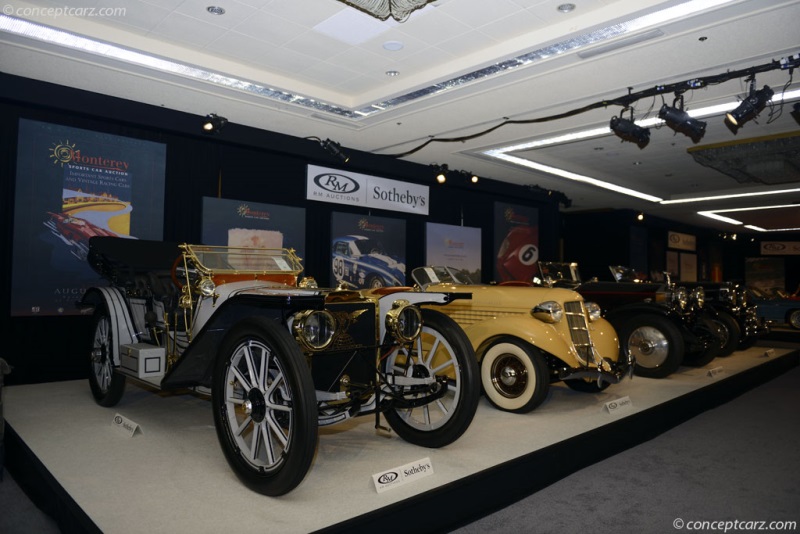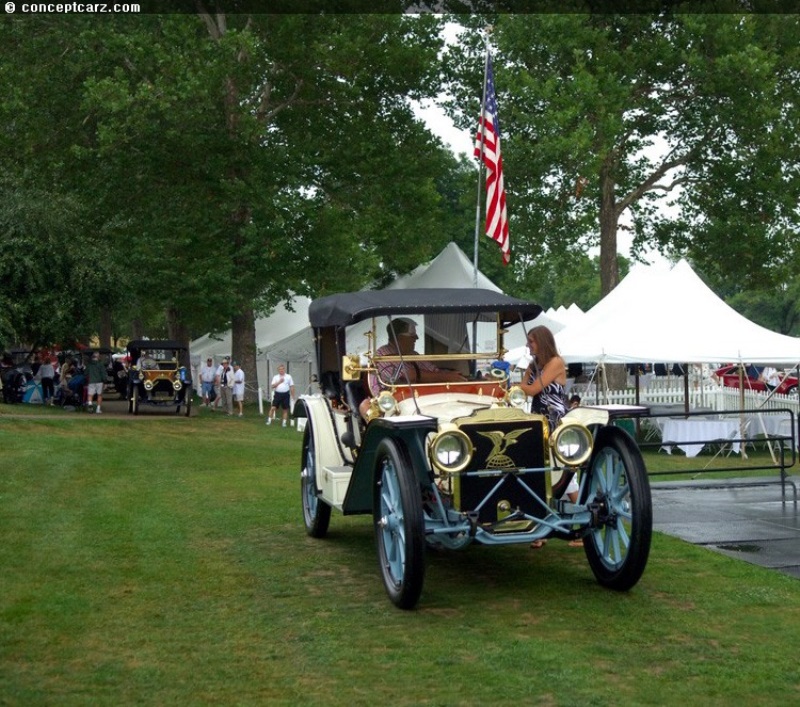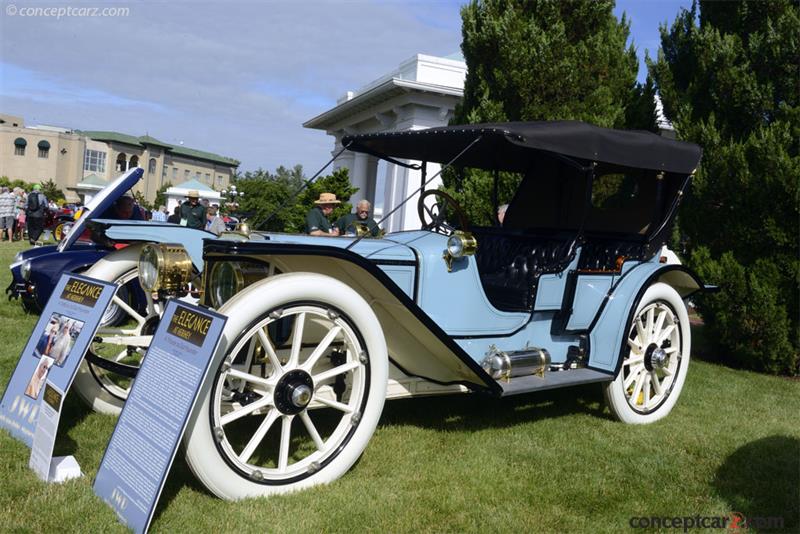History
The American Motor Car Company was founded in 1906 and based in Indianapolis, Indiana. It produced its first car in 1906 and the first 'Underslung' in 1907. However, the name 'Underslung' was not derived until 1912.
The underslung design was an attempt to make the car as low as possible. Harry C. Stutz, an engineer who would later produce cars under his own name, is credited with creating the design. Although Stutz created the chassis design, it was American's chief engineer, Fred I. Tone, who turned the chassis upside down. Tone decided to place the frame below the axles, instead of the traditional design of placing them above. The semi-elliptic leaf springs were mounted above the frame. Due to achieving such a low ground clearance, 40-inch wheels were needed to give the vehicle ample space between the frame and the ground.
The Underslung models provided safety that many other early manufacturers could not guarantee. The Underslungs were virtually impervious to roll-overs. Sales documentation stated that the vehicles could be tilted up to 55 degrees without rolling over.
The Underslung featured a four-cylinder, 6.4-liter engine capable of producing 40 horsepower. In 1908, the engine was enlarged to 7.8 liters and now produced 50 horsepower.
Even with the ground clearance advantage, the Underslung was not as competitive as other vehicles that featured larger engines. This was proven in 1908 when American Motor Car entered an Underslung Roadster in the Savannah Challenge Cup Race. The four-cylinder engine was not enough to keep pace and as a result, it finished last. Also, due to large wheels, and high center of gravity created partly by the raised engine subframe, the car suffered from poor handling and frequent tire changes.
Around 1909, American introduced a four-passenger Underslung dubbed the Traveler.
In 1910, the horsepower rating for the engine was increased to 60 by enlarging the cylinder bore and adding pressurized lubrication.
In 1911, the company faced financial difficulties. It's named was changed to American Motors Co.
In 1912, the entire model line now used the underslung chassis. As a marketing ploy, the vehicles were named the American Underslungs. Due to the size of the Traveler, a larger engine was required to make it more competitive in the market place. A six-cylinder engine was used.
In 1913, electric starters and lights became available on the Underslungs. The company still was suffering from financial problems. The company was having trouble competing with other manufacturers that were more efficient and produced bigger, faster vehicles at lower prices. Fred Tone departed from the company for other automotive opportunities.
In November of 1913, the company went into receivership. Over an eight-year period, the American Motor Company had produced over 45,000 vehicles. They had introduced creative designs, effective marketing, and brilliant automobiles. Like many other manufacturers during this era, they were plagued by ineffective assembly processes, a tough economy, the onset of World War I, and an evolving market place.
By Daniel Vaughan | Oct 2013
The underslung design was an attempt to make the car as low as possible. Harry C. Stutz, an engineer who would later produce cars under his own name, is credited with creating the design. Although Stutz created the chassis design, it was American's chief engineer, Fred I. Tone, who turned the chassis upside down. Tone decided to place the frame below the axles, instead of the traditional design of placing them above. The semi-elliptic leaf springs were mounted above the frame. Due to achieving such a low ground clearance, 40-inch wheels were needed to give the vehicle ample space between the frame and the ground.
The Underslung models provided safety that many other early manufacturers could not guarantee. The Underslungs were virtually impervious to roll-overs. Sales documentation stated that the vehicles could be tilted up to 55 degrees without rolling over.
The Underslung featured a four-cylinder, 6.4-liter engine capable of producing 40 horsepower. In 1908, the engine was enlarged to 7.8 liters and now produced 50 horsepower.
Even with the ground clearance advantage, the Underslung was not as competitive as other vehicles that featured larger engines. This was proven in 1908 when American Motor Car entered an Underslung Roadster in the Savannah Challenge Cup Race. The four-cylinder engine was not enough to keep pace and as a result, it finished last. Also, due to large wheels, and high center of gravity created partly by the raised engine subframe, the car suffered from poor handling and frequent tire changes.
Around 1909, American introduced a four-passenger Underslung dubbed the Traveler.
In 1910, the horsepower rating for the engine was increased to 60 by enlarging the cylinder bore and adding pressurized lubrication.
In 1911, the company faced financial difficulties. It's named was changed to American Motors Co.
In 1912, the entire model line now used the underslung chassis. As a marketing ploy, the vehicles were named the American Underslungs. Due to the size of the Traveler, a larger engine was required to make it more competitive in the market place. A six-cylinder engine was used.
In 1913, electric starters and lights became available on the Underslungs. The company still was suffering from financial problems. The company was having trouble competing with other manufacturers that were more efficient and produced bigger, faster vehicles at lower prices. Fred Tone departed from the company for other automotive opportunities.
In November of 1913, the company went into receivership. Over an eight-year period, the American Motor Company had produced over 45,000 vehicles. They had introduced creative designs, effective marketing, and brilliant automobiles. Like many other manufacturers during this era, they were plagued by ineffective assembly processes, a tough economy, the onset of World War I, and an evolving market place.
By Daniel Vaughan | Oct 2013
American
Similar Automakers
Similarly Priced Vehicles
- Packard Model Thirty ($4,250-$5,650)
- Stevens Duryea Model Y ($4,000-$5,000)
- Stearns Model 15-30 ($3,200-$4,600)
- Lozier Model H ($5,000-$6,000)
- Winton Model 17 ($3,000-$4,500)
- Thomas Flyer L6-40 ($3,400-$5,500)
- Pierce-Arrow Model 48 ($4,823-$6,207)
- Franklin Model H ($3,600-$5,000)
- Locomobile Model 30-L ($3,500-$4,700)
- Peerless Model 27 ($4,300-$5,800)
Average Auction Sale: $1,815,000
1910 American Traveler Underslung Vehicle Profiles
Recent Vehicle Additions
Performance and Specification Comparison
Price Comparison
Underslung Specification Comparison by Year
Year
Production
Wheelbase
Engine
Prices
110.00 in., 122.00 in., 124.00 in.
4 cyl., 475.99 CID., 50.00hp
$4,000 - $5,000
Related Automotive News

Gooding & Company Looks Toward Pebble Beach with Stunning Selection of Historic Prewar Classics
Highlights include a top-of-the-line 1930 Duesenberg Model J Disappearing-Top Convertible Coupe, a Grand Prix-winning 1929 Bugatti Type 35B, a well-documented 1914 Stutz 4E Bearcat, and an opulent 1910 Rolls-Royce 4050 HP Silver Ghost Pullman Limousine.
As...

WORLD RECORDS TUMBLE AT BONHAMS' INAUGURAL $14-MILLION AMELIA ISLAND AUCTION
Pre-war American cars sell strongly while models from Alfa Romeo, BMW and Porsche make world auction records
Amelia Island, Florida – The much-anticipated addition to the Amelia Island Car Week – whose cornerstone is the renowned Amelia...
Postwar Ferrari Named Best of Show at 2014 Pebble Beach Concours d'Elegance
1954 Ferrari 375 MM Scaglietti Coupe Named Best of Show
PEBBLE BEACH, Calif. (August 17, 2014) -- Excited cheers echoed across the 18th fairway of Pebble Beach Golf Links Sunday when a 1954 Ferrari 375 MM Scaglietti Coupe was named Best of...

RARE 1907 AMERICAN UNDERSLUNG ROADSTER TO HEADLINE BONHAMS' AUTUMN AUCTION PRESERVING THE AUTOMOBILE
Entries are now being accepted for the unique October auction at the Simeone Foundation Museum in Philadelphia
Bonhams is pleased to announce that the FC Deemer honeymoon 1907 American Underslung Roadster will be sold at auction on October...

63rd Pebble Beach Concours d'Elegance Names 1934 Packard 'Best of Show'
The competition showcased 248 cars, including 48 from abroad
PEBBLE BEACH, Calif. (August 18, 2013) -- A 1934 Packard 1108 Twelve Dietrich Convertible Victoria owned by Joseph and Margie Cassini III of West Orange, New Jersey, was named Best...

































